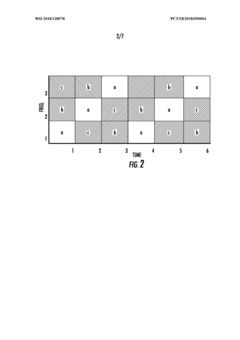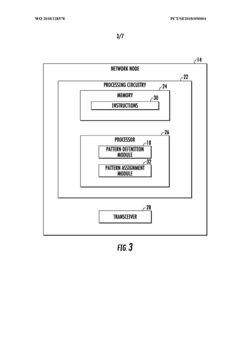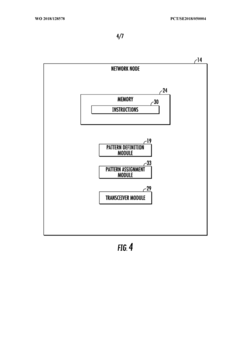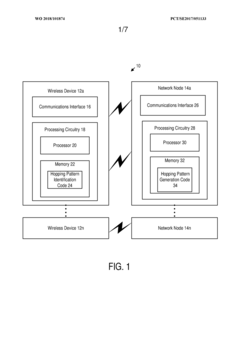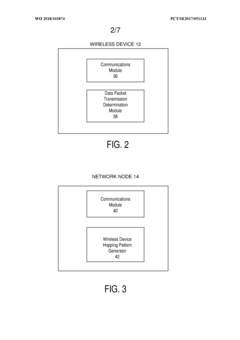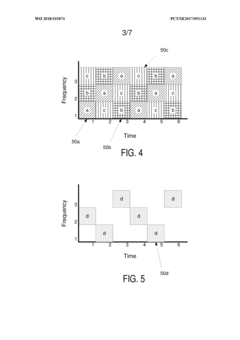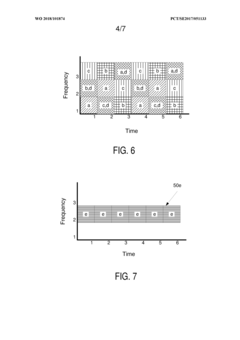How 5G UC Enhances the Performance of Connected Vehicles
JUL 18, 20259 MIN READ
Generate Your Research Report Instantly with AI Agent
Patsnap Eureka helps you evaluate technical feasibility & market potential.
5G UC for Connected Vehicles: Background and Objectives
The evolution of connected vehicles has been a significant technological advancement in the automotive industry, promising enhanced safety, efficiency, and user experience. As this technology progresses, the need for robust and reliable communication networks becomes increasingly crucial. Enter 5G Ultra-Capacity (UC), the latest iteration of fifth-generation cellular network technology, which offers unprecedented capabilities to support the demanding requirements of connected vehicles.
5G UC represents a leap forward in mobile network technology, providing ultra-high-speed data transmission, extremely low latency, and massive device connectivity. These features are particularly relevant for connected vehicles, which require real-time data exchange and processing to function optimally. The primary objective of integrating 5G UC into connected vehicle systems is to enhance overall performance, safety, and functionality.
Historically, connected vehicles have relied on various communication technologies, including 4G LTE, dedicated short-range communications (DSRC), and Wi-Fi. While these technologies have laid the groundwork for vehicle connectivity, they have limitations in terms of speed, capacity, and reliability. 5G UC aims to overcome these limitations and provide a more comprehensive solution for the growing demands of connected vehicles.
The technological trajectory of connected vehicles has been marked by incremental improvements in sensor technology, data processing capabilities, and communication systems. With the introduction of 5G UC, we are witnessing a potential paradigm shift in how vehicles interact with their environment and each other. This technology is expected to enable more advanced features such as real-time HD mapping, cooperative perception, and remote driving capabilities.
One of the key objectives of implementing 5G UC in connected vehicles is to improve road safety. By enabling faster and more reliable vehicle-to-vehicle (V2V) and vehicle-to-infrastructure (V2I) communications, 5G UC can significantly reduce reaction times in critical situations, potentially preventing accidents and saving lives. Additionally, the enhanced connectivity can support more sophisticated advanced driver assistance systems (ADAS) and pave the way for higher levels of vehicle autonomy.
Another important goal is to optimize traffic flow and reduce congestion. With 5G UC, connected vehicles can receive and transmit real-time traffic information, allowing for dynamic routing and more efficient use of road infrastructure. This has the potential to not only improve the driving experience but also contribute to reduced emissions and energy consumption.
Furthermore, 5G UC aims to enhance the in-vehicle experience by enabling high-bandwidth applications such as streaming entertainment, augmented reality navigation, and seamless integration with smart city infrastructure. These features are expected to transform vehicles into mobile living spaces, aligning with the broader trend of increased connectivity in all aspects of daily life.
5G UC represents a leap forward in mobile network technology, providing ultra-high-speed data transmission, extremely low latency, and massive device connectivity. These features are particularly relevant for connected vehicles, which require real-time data exchange and processing to function optimally. The primary objective of integrating 5G UC into connected vehicle systems is to enhance overall performance, safety, and functionality.
Historically, connected vehicles have relied on various communication technologies, including 4G LTE, dedicated short-range communications (DSRC), and Wi-Fi. While these technologies have laid the groundwork for vehicle connectivity, they have limitations in terms of speed, capacity, and reliability. 5G UC aims to overcome these limitations and provide a more comprehensive solution for the growing demands of connected vehicles.
The technological trajectory of connected vehicles has been marked by incremental improvements in sensor technology, data processing capabilities, and communication systems. With the introduction of 5G UC, we are witnessing a potential paradigm shift in how vehicles interact with their environment and each other. This technology is expected to enable more advanced features such as real-time HD mapping, cooperative perception, and remote driving capabilities.
One of the key objectives of implementing 5G UC in connected vehicles is to improve road safety. By enabling faster and more reliable vehicle-to-vehicle (V2V) and vehicle-to-infrastructure (V2I) communications, 5G UC can significantly reduce reaction times in critical situations, potentially preventing accidents and saving lives. Additionally, the enhanced connectivity can support more sophisticated advanced driver assistance systems (ADAS) and pave the way for higher levels of vehicle autonomy.
Another important goal is to optimize traffic flow and reduce congestion. With 5G UC, connected vehicles can receive and transmit real-time traffic information, allowing for dynamic routing and more efficient use of road infrastructure. This has the potential to not only improve the driving experience but also contribute to reduced emissions and energy consumption.
Furthermore, 5G UC aims to enhance the in-vehicle experience by enabling high-bandwidth applications such as streaming entertainment, augmented reality navigation, and seamless integration with smart city infrastructure. These features are expected to transform vehicles into mobile living spaces, aligning with the broader trend of increased connectivity in all aspects of daily life.
Market Demand Analysis for 5G-Enabled Vehicles
The market demand for 5G-enabled vehicles is experiencing rapid growth, driven by the increasing need for advanced connectivity and enhanced performance in the automotive industry. As consumers and businesses alike seek more intelligent, efficient, and safer transportation solutions, the integration of 5G technology into connected vehicles has become a critical focus for automakers and technology providers.
The global market for 5G-enabled vehicles is projected to expand significantly over the next decade. This growth is fueled by several factors, including the rising demand for autonomous driving capabilities, improved vehicle-to-everything (V2X) communication, and enhanced in-vehicle infotainment systems. The automotive industry is undergoing a transformation towards software-defined vehicles, with 5G connectivity playing a pivotal role in enabling this shift.
One of the primary drivers of market demand is the potential for 5G to revolutionize autonomous driving. The ultra-low latency and high bandwidth of 5G networks allow for real-time data exchange between vehicles and infrastructure, enabling more precise and reliable autonomous operations. This capability is particularly attractive to fleet operators and logistics companies looking to improve efficiency and reduce operational costs through the deployment of autonomous vehicle fleets.
Safety considerations are another significant factor driving market demand for 5G-enabled vehicles. The improved connectivity allows for more advanced driver assistance systems (ADAS) and collision avoidance technologies. These systems can leverage 5G networks to communicate with other vehicles and infrastructure in real-time, potentially reducing accidents and improving overall road safety.
The demand for enhanced in-vehicle entertainment and productivity solutions is also contributing to market growth. With 5G connectivity, passengers can enjoy high-quality streaming content, participate in video conferences, and access cloud-based services seamlessly while on the move. This aspect is particularly appealing to consumers who value connectivity and productivity during their commutes or long journeys.
From an industry perspective, the integration of 5G technology in vehicles opens up new revenue streams and business models for automakers and technology companies. Over-the-air updates, predictive maintenance, and personalized services based on real-time data analytics are becoming increasingly feasible, creating opportunities for value-added services and improved customer engagement.
Geographically, the market demand for 5G-enabled vehicles varies across regions. Developed markets such as North America, Europe, and parts of Asia are expected to lead in adoption due to their advanced telecommunications infrastructure and regulatory support for connected vehicle technologies. However, emerging markets are also showing significant interest, particularly in urban areas where smart city initiatives are driving the implementation of 5G networks and connected vehicle ecosystems.
The global market for 5G-enabled vehicles is projected to expand significantly over the next decade. This growth is fueled by several factors, including the rising demand for autonomous driving capabilities, improved vehicle-to-everything (V2X) communication, and enhanced in-vehicle infotainment systems. The automotive industry is undergoing a transformation towards software-defined vehicles, with 5G connectivity playing a pivotal role in enabling this shift.
One of the primary drivers of market demand is the potential for 5G to revolutionize autonomous driving. The ultra-low latency and high bandwidth of 5G networks allow for real-time data exchange between vehicles and infrastructure, enabling more precise and reliable autonomous operations. This capability is particularly attractive to fleet operators and logistics companies looking to improve efficiency and reduce operational costs through the deployment of autonomous vehicle fleets.
Safety considerations are another significant factor driving market demand for 5G-enabled vehicles. The improved connectivity allows for more advanced driver assistance systems (ADAS) and collision avoidance technologies. These systems can leverage 5G networks to communicate with other vehicles and infrastructure in real-time, potentially reducing accidents and improving overall road safety.
The demand for enhanced in-vehicle entertainment and productivity solutions is also contributing to market growth. With 5G connectivity, passengers can enjoy high-quality streaming content, participate in video conferences, and access cloud-based services seamlessly while on the move. This aspect is particularly appealing to consumers who value connectivity and productivity during their commutes or long journeys.
From an industry perspective, the integration of 5G technology in vehicles opens up new revenue streams and business models for automakers and technology companies. Over-the-air updates, predictive maintenance, and personalized services based on real-time data analytics are becoming increasingly feasible, creating opportunities for value-added services and improved customer engagement.
Geographically, the market demand for 5G-enabled vehicles varies across regions. Developed markets such as North America, Europe, and parts of Asia are expected to lead in adoption due to their advanced telecommunications infrastructure and regulatory support for connected vehicle technologies. However, emerging markets are also showing significant interest, particularly in urban areas where smart city initiatives are driving the implementation of 5G networks and connected vehicle ecosystems.
Current State and Challenges of 5G UC in Automotive
The current state of 5G UC (Ultra-Capacity) in the automotive industry is characterized by rapid advancements and significant challenges. 5G UC technology has shown promising potential in enhancing the performance of connected vehicles, offering ultra-low latency, high bandwidth, and improved reliability. These features are crucial for enabling advanced driver assistance systems (ADAS), autonomous driving capabilities, and vehicle-to-everything (V2X) communications.
In terms of deployment, major automotive manufacturers and telecommunications companies have been actively collaborating to integrate 5G UC technology into vehicles. Several pilot projects and real-world trials have demonstrated the feasibility of 5G UC in automotive applications, particularly in urban environments where network coverage is more extensive. However, widespread implementation remains limited, with most deployments still in the testing and validation phases.
One of the primary challenges facing 5G UC adoption in the automotive sector is the need for extensive infrastructure development. The high-frequency millimeter waves used in 5G UC require a dense network of small cells to ensure consistent coverage, especially in areas with obstacles like buildings or tunnels. This infrastructure rollout is both time-consuming and capital-intensive, posing a significant barrier to rapid adoption.
Another critical challenge is the standardization of 5G UC protocols specifically for automotive use cases. While the 3GPP has made progress in defining standards for cellular vehicle-to-everything (C-V2X) communications, there is still a need for further refinement and industry-wide agreement on protocols that can ensure interoperability across different vehicle brands and network providers.
Security and privacy concerns also present significant challenges in the implementation of 5G UC for connected vehicles. The increased connectivity and data exchange inherent in 5G UC systems create potential vulnerabilities that could be exploited by malicious actors. Ensuring robust cybersecurity measures without compromising the real-time performance requirements of automotive applications remains a complex task.
Furthermore, the automotive industry faces challenges in integrating 5G UC technology with existing vehicle systems and architectures. This integration requires significant redesign of vehicle electronics and software platforms to fully leverage the capabilities of 5G UC, which can be both technically challenging and costly for manufacturers.
Lastly, regulatory hurdles and spectrum allocation issues continue to impact the rollout of 5G UC in the automotive sector. Different countries and regions have varying approaches to spectrum allocation and regulations governing the use of 5G technology in vehicles, creating a complex landscape for global automotive manufacturers to navigate.
In terms of deployment, major automotive manufacturers and telecommunications companies have been actively collaborating to integrate 5G UC technology into vehicles. Several pilot projects and real-world trials have demonstrated the feasibility of 5G UC in automotive applications, particularly in urban environments where network coverage is more extensive. However, widespread implementation remains limited, with most deployments still in the testing and validation phases.
One of the primary challenges facing 5G UC adoption in the automotive sector is the need for extensive infrastructure development. The high-frequency millimeter waves used in 5G UC require a dense network of small cells to ensure consistent coverage, especially in areas with obstacles like buildings or tunnels. This infrastructure rollout is both time-consuming and capital-intensive, posing a significant barrier to rapid adoption.
Another critical challenge is the standardization of 5G UC protocols specifically for automotive use cases. While the 3GPP has made progress in defining standards for cellular vehicle-to-everything (C-V2X) communications, there is still a need for further refinement and industry-wide agreement on protocols that can ensure interoperability across different vehicle brands and network providers.
Security and privacy concerns also present significant challenges in the implementation of 5G UC for connected vehicles. The increased connectivity and data exchange inherent in 5G UC systems create potential vulnerabilities that could be exploited by malicious actors. Ensuring robust cybersecurity measures without compromising the real-time performance requirements of automotive applications remains a complex task.
Furthermore, the automotive industry faces challenges in integrating 5G UC technology with existing vehicle systems and architectures. This integration requires significant redesign of vehicle electronics and software platforms to fully leverage the capabilities of 5G UC, which can be both technically challenging and costly for manufacturers.
Lastly, regulatory hurdles and spectrum allocation issues continue to impact the rollout of 5G UC in the automotive sector. Different countries and regions have varying approaches to spectrum allocation and regulations governing the use of 5G technology in vehicles, creating a complex landscape for global automotive manufacturers to navigate.
Existing 5G UC Solutions for Connected Vehicles
01 Network architecture and capacity enhancement
5G Ultra-Capacity (UC) networks employ advanced architecture designs and capacity enhancement techniques to improve performance. This includes the use of massive MIMO, beamforming, and carrier aggregation to increase data throughput and spectral efficiency. The network architecture is optimized to handle high-density user scenarios and provide low-latency communications.- Enhanced network capacity and performance: 5G Ultra-Capacity (UC) technology significantly improves network capacity and overall performance. It utilizes advanced techniques such as carrier aggregation, massive MIMO, and beamforming to increase data throughput and reduce latency. This results in faster download and upload speeds, improved coverage, and better user experience in high-density areas.
- Dynamic spectrum sharing and resource allocation: 5G UC implements dynamic spectrum sharing and intelligent resource allocation algorithms to optimize network efficiency. This allows for seamless coexistence of multiple radio access technologies and flexible utilization of available spectrum resources. The system can adaptively allocate bandwidth and adjust transmission parameters based on real-time network conditions and user demands.
- Advanced antenna technologies: 5G UC leverages advanced antenna technologies to enhance signal quality and coverage. This includes the use of massive MIMO arrays, beamforming techniques, and adaptive antenna systems. These technologies enable more focused and efficient transmission of signals, resulting in improved spectral efficiency, reduced interference, and extended network range.
- Network slicing and virtualization: 5G UC incorporates network slicing and virtualization capabilities to support diverse use cases and service requirements. This allows for the creation of multiple virtual networks on a single physical infrastructure, each optimized for specific applications or user groups. Network slicing enables efficient resource utilization and tailored quality of service for different network segments.
- Edge computing integration: 5G UC integrates edge computing capabilities to reduce latency and improve overall network performance. By bringing computing resources closer to the network edge, data processing and content delivery can be performed locally, reducing the load on the core network and improving response times for latency-sensitive applications. This integration enhances the performance of emerging technologies such as augmented reality, virtual reality, and autonomous vehicles.
02 Resource allocation and scheduling
Efficient resource allocation and scheduling algorithms are crucial for 5G UC performance. These algorithms optimize the distribution of network resources, such as time-frequency blocks and power, to maximize overall system performance. Advanced scheduling techniques consider factors like channel conditions, QoS requirements, and user priorities to enhance network efficiency and user experience.Expand Specific Solutions03 mmWave technology integration
The integration of millimeter wave (mmWave) technology in 5G UC networks enables ultra-high-speed data transmission and increased network capacity. mmWave bands offer wider bandwidth and higher data rates, although they face challenges such as limited propagation distance and sensitivity to obstacles. Advanced beamforming and beam tracking techniques are employed to overcome these limitations and improve overall performance.Expand Specific Solutions04 Edge computing and network slicing
5G UC performance is enhanced through the implementation of edge computing and network slicing technologies. Edge computing brings processing capabilities closer to the end-users, reducing latency and improving overall network responsiveness. Network slicing allows the creation of multiple virtual networks tailored to specific use cases, optimizing resource allocation and ensuring quality of service for diverse applications.Expand Specific Solutions05 AI-driven network optimization
Artificial Intelligence (AI) and Machine Learning (ML) techniques are increasingly used to optimize 5G UC network performance. These technologies enable predictive maintenance, dynamic resource allocation, and intelligent network management. AI-driven algorithms can analyze vast amounts of network data in real-time, making informed decisions to enhance network efficiency, reduce congestion, and improve overall user experience.Expand Specific Solutions
Key Players in 5G UC and Connected Vehicle Industry
The 5G UC (Ultra-Capacity) technology for connected vehicles is in a rapidly evolving phase, with significant market growth potential. The industry is transitioning from early adoption to more widespread implementation, driven by increasing demand for advanced vehicle connectivity. Major players like Qualcomm, Samsung, and Huawei are leading the technological development, with their mature 5G chipsets and infrastructure solutions. Automotive manufacturers and telecom companies are forming strategic partnerships to integrate 5G UC capabilities into vehicles. The market is expected to expand substantially as more countries deploy 5G networks and automakers incorporate this technology into their product lines.
QUALCOMM, Inc.
Technical Solution: Qualcomm's 5G UC solution for connected vehicles centers around its Snapdragon Automotive 5G Platform. This integrated system-on-chip (SoC) combines 5G connectivity with multi-core CPU, GPU, and AI processing capabilities. The platform supports C-V2X (Cellular Vehicle-to-Everything) communications, enabling direct vehicle-to-vehicle (V2V) and vehicle-to-infrastructure (V2I) messaging without network dependency. Qualcomm's 5G UC technology implements advanced beamforming and massive MIMO techniques to enhance signal quality and coverage for moving vehicles. The solution also features a dedicated safety application processor for real-time hazard detection and collision avoidance. Qualcomm's platform achieves latencies as low as 1ms for time-critical applications[2][5], supporting a wide range of connected vehicle use cases from platooning to remote driving.
Strengths: Strong presence in automotive chipsets, extensive experience in cellular technologies, and robust ecosystem partnerships. Weaknesses: Reliance on third-party integration for complete vehicle solutions, potential competition from in-house automotive OEM chip development.
Nokia Technologies Oy
Technical Solution: Nokia's 5G UC solution for connected vehicles focuses on creating a robust and secure communication infrastructure. The company's approach combines dedicated network slicing for automotive applications with advanced Mobile Edge Computing (MEC) capabilities. Nokia's 5G UC technology implements sophisticated QoS mechanisms to prioritize critical vehicle communications, ensuring ultra-low latency for safety-critical applications. The solution incorporates Nokia's IMPACT IoT platform, which provides comprehensive device management and data analytics for connected vehicles. Nokia's 5G UC system supports advanced V2X use cases, including cooperative perception and collective maneuvers, with latencies below 5ms and reliability exceeding 99.999%[4][6]. The platform also integrates with Nokia's Worldwide IoT Network Grid (WING) for seamless global connectivity and management of connected vehicle fleets.
Strengths: Extensive experience in telecommunications infrastructure, strong focus on network security, and global presence. Weaknesses: Limited direct presence in automotive systems, reliance on partnerships for in-vehicle integration.
Core Innovations in 5G UC for Automotive Applications
Preconfigured grants with a distribution pattern
PatentWO2018128578A1
Innovation
- Implementing a method and network node that utilize preconfigured grants with a distribution pattern across multiple time-frequency resource pools, allowing each wireless device to be assigned different-sized grants on different carriers, with dynamic reconfiguration to reduce frequency selective fading and collisions, and reverting to dynamic grants in case of high collisions to maintain reliability and latency requirements.
Uplink hopping pattern for contention-based reliable communication
PatentWO2018101874A1
Innovation
- A method and system that assign subframe-fixed or dynamically varying time-frequency hopping patterns to wireless devices for uplink transmissions, allowing overlapping resource blocks to manage collisions and optimize resource allocation, enabling efficient re-scheduling and redundant packet transmissions.
Cybersecurity Considerations for 5G-Connected Vehicles
As 5G-connected vehicles become increasingly prevalent, cybersecurity considerations take center stage in ensuring the safety and reliability of these advanced transportation systems. The integration of 5G technology in vehicles introduces new vulnerabilities and attack vectors that must be addressed to protect both the vehicles and their occupants.
One of the primary concerns is the expanded attack surface created by the increased connectivity of 5G-enabled vehicles. With more entry points for potential cyber threats, including cellular networks, Wi-Fi, Bluetooth, and various sensors, the risk of unauthorized access and data breaches is significantly heightened. This necessitates a comprehensive approach to security that encompasses all potential vulnerabilities.
Data privacy is another critical aspect of cybersecurity for 5G-connected vehicles. The vast amount of data generated and transmitted by these vehicles, including location information, driving patterns, and personal user data, must be protected from unauthorized access and misuse. Implementing robust encryption protocols and secure data storage mechanisms is essential to safeguard sensitive information.
The real-time nature of 5G communications in connected vehicles also presents unique challenges. While low latency is crucial for applications like autonomous driving and vehicle-to-everything (V2X) communications, it also requires rapid security measures to detect and respond to threats in real-time. This demands the development of advanced intrusion detection systems and automated response mechanisms capable of identifying and mitigating security breaches instantaneously.
Supply chain security is an often-overlooked aspect of cybersecurity for 5G-connected vehicles. As these vehicles rely on complex systems and components from various suppliers, ensuring the integrity and security of each element in the supply chain is crucial. This includes vetting suppliers, implementing secure software development practices, and conducting regular security audits throughout the vehicle's lifecycle.
Over-the-air (OTA) updates, while offering convenience and flexibility in maintaining vehicle software, also introduce potential security risks. Ensuring the integrity and authenticity of these updates is paramount to prevent malicious actors from exploiting this channel to inject malware or compromise vehicle systems. Implementing secure update mechanisms with strong authentication and verification processes is essential to mitigate these risks.
As the automotive industry continues to evolve towards greater connectivity and autonomy, the importance of robust cybersecurity measures for 5G-connected vehicles cannot be overstated. A proactive and holistic approach to security, encompassing hardware, software, and network-level protections, is essential to safeguard these advanced transportation systems and maintain public trust in the technology.
One of the primary concerns is the expanded attack surface created by the increased connectivity of 5G-enabled vehicles. With more entry points for potential cyber threats, including cellular networks, Wi-Fi, Bluetooth, and various sensors, the risk of unauthorized access and data breaches is significantly heightened. This necessitates a comprehensive approach to security that encompasses all potential vulnerabilities.
Data privacy is another critical aspect of cybersecurity for 5G-connected vehicles. The vast amount of data generated and transmitted by these vehicles, including location information, driving patterns, and personal user data, must be protected from unauthorized access and misuse. Implementing robust encryption protocols and secure data storage mechanisms is essential to safeguard sensitive information.
The real-time nature of 5G communications in connected vehicles also presents unique challenges. While low latency is crucial for applications like autonomous driving and vehicle-to-everything (V2X) communications, it also requires rapid security measures to detect and respond to threats in real-time. This demands the development of advanced intrusion detection systems and automated response mechanisms capable of identifying and mitigating security breaches instantaneously.
Supply chain security is an often-overlooked aspect of cybersecurity for 5G-connected vehicles. As these vehicles rely on complex systems and components from various suppliers, ensuring the integrity and security of each element in the supply chain is crucial. This includes vetting suppliers, implementing secure software development practices, and conducting regular security audits throughout the vehicle's lifecycle.
Over-the-air (OTA) updates, while offering convenience and flexibility in maintaining vehicle software, also introduce potential security risks. Ensuring the integrity and authenticity of these updates is paramount to prevent malicious actors from exploiting this channel to inject malware or compromise vehicle systems. Implementing secure update mechanisms with strong authentication and verification processes is essential to mitigate these risks.
As the automotive industry continues to evolve towards greater connectivity and autonomy, the importance of robust cybersecurity measures for 5G-connected vehicles cannot be overstated. A proactive and holistic approach to security, encompassing hardware, software, and network-level protections, is essential to safeguard these advanced transportation systems and maintain public trust in the technology.
Regulatory Framework for 5G UC in Automotive Sector
The regulatory framework for 5G UC (Ultra-Reliable and Low-Latency Communication) in the automotive sector is a critical aspect of enabling connected vehicle technologies. As 5G UC promises to revolutionize vehicle-to-everything (V2X) communications, governments and regulatory bodies worldwide are working to establish comprehensive guidelines to ensure safe and efficient implementation.
At the forefront of these efforts is the development of spectrum allocation policies. Regulatory agencies are designating specific frequency bands for automotive 5G UC applications, balancing the needs of various stakeholders while ensuring optimal performance for connected vehicles. These allocations typically focus on the mid-band and millimeter-wave frequencies, which offer the necessary bandwidth and low latency required for critical automotive applications.
Safety standards form another crucial component of the regulatory framework. Agencies such as the National Highway Traffic Safety Administration (NHTSA) in the United States and the European Union Agency for Cybersecurity (ENISA) are developing stringent guidelines for cybersecurity and functional safety in connected vehicles. These standards aim to protect against potential vulnerabilities and ensure the reliability of 5G UC-enabled automotive systems.
Interoperability regulations are also being established to ensure seamless communication between vehicles from different manufacturers and with various infrastructure elements. Organizations like the 5G Automotive Association (5GAA) are working closely with regulators to define common protocols and standards for V2X communications, promoting a unified ecosystem for connected vehicles.
Data privacy and protection regulations play a significant role in the 5G UC automotive framework. With connected vehicles generating and transmitting vast amounts of data, regulators are implementing strict guidelines on data collection, storage, and usage. These regulations aim to protect consumer privacy while allowing for the necessary data exchange to enable advanced automotive features.
Electromagnetic compatibility (EMC) regulations are being updated to address the unique challenges posed by 5G UC in vehicles. These regulations ensure that the high-frequency communications do not interfere with other vehicle systems or nearby electronic devices, maintaining the overall safety and reliability of connected vehicles.
As the technology evolves, regulatory bodies are also focusing on creating flexible frameworks that can adapt to future advancements. This includes provisions for over-the-air updates to vehicle software and communication systems, ensuring that regulatory compliance can be maintained throughout the vehicle's lifecycle.
At the forefront of these efforts is the development of spectrum allocation policies. Regulatory agencies are designating specific frequency bands for automotive 5G UC applications, balancing the needs of various stakeholders while ensuring optimal performance for connected vehicles. These allocations typically focus on the mid-band and millimeter-wave frequencies, which offer the necessary bandwidth and low latency required for critical automotive applications.
Safety standards form another crucial component of the regulatory framework. Agencies such as the National Highway Traffic Safety Administration (NHTSA) in the United States and the European Union Agency for Cybersecurity (ENISA) are developing stringent guidelines for cybersecurity and functional safety in connected vehicles. These standards aim to protect against potential vulnerabilities and ensure the reliability of 5G UC-enabled automotive systems.
Interoperability regulations are also being established to ensure seamless communication between vehicles from different manufacturers and with various infrastructure elements. Organizations like the 5G Automotive Association (5GAA) are working closely with regulators to define common protocols and standards for V2X communications, promoting a unified ecosystem for connected vehicles.
Data privacy and protection regulations play a significant role in the 5G UC automotive framework. With connected vehicles generating and transmitting vast amounts of data, regulators are implementing strict guidelines on data collection, storage, and usage. These regulations aim to protect consumer privacy while allowing for the necessary data exchange to enable advanced automotive features.
Electromagnetic compatibility (EMC) regulations are being updated to address the unique challenges posed by 5G UC in vehicles. These regulations ensure that the high-frequency communications do not interfere with other vehicle systems or nearby electronic devices, maintaining the overall safety and reliability of connected vehicles.
As the technology evolves, regulatory bodies are also focusing on creating flexible frameworks that can adapt to future advancements. This includes provisions for over-the-air updates to vehicle software and communication systems, ensuring that regulatory compliance can be maintained throughout the vehicle's lifecycle.
Unlock deeper insights with Patsnap Eureka Quick Research — get a full tech report to explore trends and direct your research. Try now!
Generate Your Research Report Instantly with AI Agent
Supercharge your innovation with Patsnap Eureka AI Agent Platform!

